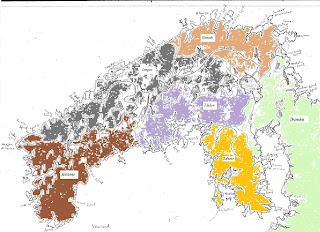Hi all i'm currently south of Perpignan in the moutains, not very far from Spain. Where we're staying is on the side of a moutain and at the moment it's throwing it down with rain. Perfect for blogging.
As i'm going to start a Runissia dux campaign soon, i thought i'd introduce some of the names/ideas and what not about this place. Sorry for those historical gamers out there, but it own't be all Runissia!
Being at the mountains is quite convinent, since Runissia is mostly mountains.
Introduction:
Runissia in on the northern most part of my fantasy world, with it's eastern border on Kindarr. To the south in the Shallow Sea and the Kaliad lands, often called Kaliad Shore. It is a cold and mountainous land, being cut almost in two by the huge Korkn Mountains. To the east the lands are flatter and more like Kindarr with rolling hills and vast lakes, while the northern tip is wild and harsh.
The seasons here are not like our own world; the calendar is split into 4 season years, birthing, flourishing, falling and sleeping year. In each of the season years there is a spring, summer, autumn and winter, just like our own, but they differdepending on the season year. So in the flourishing year, there might not be snow in winter, while in the sleeping year it has been known to snow even in summer. A cycle of four years is known as a Hudyar, basically '4 years'.
History:
Runissia is an ancient nation, first formed when the legendary Rafans invaded in the year -36 according to Benden, the first Runissian historial. Before this the land was split into clans and tribal lands who fought and traded, and joined together to fight the Rafan invaders.
The Rafan wars were bloody despite the lack of major battles, as the native populations used hit and run tactics and the invaders employed a scorched ground policy, and in the end forced the native population to give in. In the year 1 Tylk the noble, the Rafan leader, was crowned king in Hanbrik.
The Rafan power was concentrated in the west, and in the north and east the lands were still very much 'barbarian'. The situation remained as such until 187, when Salyr 'the weak' abandoned Runissia and left over sea. Runissia returned to the pre-Rafan period until 203 with the rise of Malan and Karles a year after. Malan was a western warlord who based his new land, Fladia, upon old Rafan traditions and systems, while Karles was more of a traditionalist in the east, having never seen Rafan power. This eastern land was called Bulkdrom. The two powers came to blows in the Wars of the Birds, called so because the two powers used birds as their badges.
In 204, exactly 100 years after the forming of Bulkdrom, Karles' successors conquerored the west and formed Bulkdia. This nation included all of modern Runissia except Kwenth in the north, that managed to remain independant until 392 when it was conquerored and included into Bulkdia.
The line of kings was strong but the Fraal incursions (408-419) destabilised the realm and weakened royal power. It was then Ceres, a Longon furjuk and victor of many battles against the invading Fraals, made a bid for power. Unable to resist, the last Bulkdian king Etethel went into exile. Ceres crowned himself king in 420 as Ceres I.
From then until now, in 654 the Runissian line has ruled. The land was heavily damaged during the 'Crow Wars', a long civil war between rivaling houses that brought Runissia to it's knees and opened it to foreign enemies. Now Romin, the current king, has gone to great efforts to restore Runissia to it's former power.
Titles and land:
Runissia is ruled by the Taludarn (king) who rules over all of Runissia and makes it's laws and leads the armies against foreign foes. He resides in the royal palace at Hanbrik. (Taludarn is derived from Talud, the Runissian word for mountain)
To help him rule this land, there are several furjuks (dukes) who rule one of the furjukhors; Kwenth, Dramdon, Fladon, Merkena, Bakuna and Longon.
Land is divided into between the Jeruds (nobles), powerful Jeruds being called Derlens (earls). These men ensure the peace is kept on their lands and collect taxes from the brasirs and filfyrs.
Farm land is divided into haeths, the land that can feel a family. Filfyrs are men who own at least 6 haeths but are not nobles, brasirs are those men under the filfyrs, but are still freemen. Under brasirs are the slaves, who have few rights and are not allowed to bear arms.
Next time, Runissia at war, Kaliad and ideas for Dux Britanniarum.


Aucun commentaire:
Enregistrer un commentaire